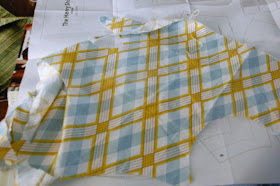Today, we cut.
Cutting is not my favorite step of the sewing process. OK, that's probably true for 90% of sewists. But yes, like most, I dread the cutting and wish I could get right to the sewing.
I will say though, that if you know ahead of time that all you are going to do is cut, that the sewing won't begin until the next day, it makes the chore of cutting less offensive. You know you're not sewing today anyway. You're just getting things ready. And it's one part of the sewing process I find you can do with kids running around. When I sit at the sewing machine, suddenly the kids need me for 45 things, and I feel guilty if I'm not being attentive to them. But when I cut, they just play around me. Not so bad!
 |
| Keeping it real! Here's the mess that is my dining room when I'm cutting fabric. |
OK, brief cute-baby interruption over. Back to cutting!
For the Henry Shirt, you'll be cutting out 14 pieces from your two fabrics and a few pieces of interfacing. The nice thing about Sewing for Boys is that all the pattern pieces you need for a project come on one piece of paper, and everything is spread out. No crazy overlapping pattern lines or searching for the other parts of the pattern, like I've seen in some books.
Unless you are using the biggest size and will never need a smaller one AND you don't care to ever use the pattern on the back, you'll need to trace the pattern pieces and cut them out of something else.
There are official tracing papers out there, but I tend to use what I have on hand. Freezer paper is a good choice, because you can iron it right onto your fabric and then peel it off. I have also used tissue paper in the past. This day, I had neither on hand, so I used the thing I had handy -- wax paper.
I traced the pieces onto the wax paper, labeled them with all of the notes from the pattern and cut them out. Then you lay it on the fabric and pin and either cut or trace with an air erasing marker. (Or if you're like me, just use the wrong side and faintly trace in pen.)
I so did not have enough of this plaid! But the solution, I think, will be easy enough. I'll make the sleeves/yoke part that will go inside the sleeve out of the white fabric. (Or maybe something different, I might change that up.)
One thing to note: be sure to pay attention to what pieces need to be cut on the bias. If you mark the arrows down from the pattern onto your pieces, you'll be able to find the right way to lay them out very easily. And won't forget!
Also be sure to pay attention to the direction of your fabric, if it has one. Both my plaid and the robots have a direction. So I had to make sure that my pieces would match.
And last thing to remember! For the front pieces, be sure to cut one and then flip the pattern over to cut the other. Or fold the fabric right sides together and cut two, so they'll be mirror images.
Another way to trace your fabric is to use drawing paper. This is a large roll of drawing paper from Ikea. It's barely transparent, but if you smooth the paper down in a sunny room, you'll be able to see through it. This creates sturdy, durable pattern pieces you'll be able to use over and over.
My customer approves.
Here are all my pieces cut and ready to go (except for those white inner sleeve parts.)
Can't wait to get sewing tomorrow!
Don't forget to drop a link in the comments if you are participating so we can come and visit. And check out Leila's take on cutting at her blog, Bilingual Baby!









Looking great! And I'm glad you didn't have my brain freeze with the direction of the fabric. Love your prints.
ReplyDelete